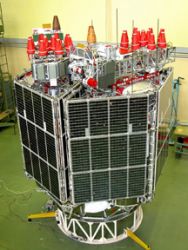Speakers at the low-in-profile but high-in-content International Association of Institutes of Navigation (IAIN) conference in Prague this year threw into stark relief some of the big GNSS programs and even bigger GNSS questions.
Speakers at the low-in-profile but high-in-content International Association of Institutes of Navigation (IAIN) conference in Prague this year threw into stark relief some of the big GNSS programs and even bigger GNSS questions.
We’ll let Prof.-Dr. Günter Hein, former head of the European Space Agency (ESA) EGNOS and GNSS Evolution Program Department and Emeritus of Excellence at University FAF Munich, start the show. Hein delivered a fact-filled and level-headed presentation on the status of Galileo, the European Union’s civil-owned and non-military GNSS, with slides and information provided by ESA.
The civil owner of Galileo, namely the European Commission (EC), working hand-in-hand with ESA, has struggled to keep the program on course and on schedule, but now 10 Galileo satellites are now in orbit, most of which are functioning normally.
Following the latest launch of two Galileo satellites in September, a recent ESA communication states that the next Galileo launch — onboard a Soyuz rocket and the third to take place in 2015 — will go ahead on December 17. It will carry Galileo satellites 11 and 12 now ready and waiting at Europe’s Spaceport in French Guiana.
Hein discussed the status of several Galileo satellites currently on deck, in various stages of preparation, with the next launch to follow the one in December, this time onboard an Ariane-5 rocket, set for October 2016. He also outlined work to finalize the Galileo ground mission segment.
“The program’s top objective,” Hein said, “is to ramp-up, roll out, stabilize and provide committed Galileo services 24/7 to the user community,” all of which goes without saying. But he also laid out the program’s vision beyond full operational capability.
“It may sound a bit crazy,” he said, “talking about a next generation when the first-generation system is not yet operational, but there is a future and we need to plan for it.”
Current work on Galileo’s Next GEN, Hein explained, is concerned first with identifying architecture- evolution drivers linked to mass and professional markets, governmental users, and search and rescue services. Then there is infrastructure evolution, with a clear intent on the part of the program to apply lessons learned.
The program is working to identify performance drivers, assessing key architecture building blocks and developing new architecture options, and, importantly, putting together a clear vision for where the program wants to go and a concrete transition scenario. (A Thought Leadership Series question and answer column will appear in an upcoming issue of Inside GNSS featuring Hein discussing the Galileo Evolutions program in greater detail.)
In conclusion, Hein said, “Galileo works, FOC [full operational capability] satellite production is well under way, the ground segment is ‘early services-ready,’ and space segment deployment is proceeding based on Soyuz and Ariane-5 launch capabilities.”
The mission to recover the ill-fated Galileo satellites launched into anomalous orbit last year is continuing, he said, with plans to put them to the best possible use, whatever that may be, although they will probably never be able to fulfill their originally intended functions.
Everyone seemed to appreciate Hein’s candor.
Vítejte v Praze
Of the speakers arrayed at the head of the room in Prague, aside from some local politicians, only Jean- Marc Pieplu, EGNOS Exploitation Program manager for the European GNSS Agency (GSA), was qualified to offer an authentic Vítejte v Praze (“Welcome to Prague”) message. The GSA, charged with delivering Galileo services, has for some years made its home in the Czech capital, well away from the hectic and complicated EU headquarters in Brussels.
Pieplu described a new EGNOS-based “localizer performance with vertical guidance” (LPV) service with 200-foot decision height for aircraft approach and landing. EGNOS — formally (and lengthily) the European Geostationary Navigation Overlay Service — is the European counterpart to America’s GPS Wide Area Augmentation System (WAAS). And he announced the launch of the procurement process for EGNOS V3, which will feature dual-frequency capabilities.
As for early Galileo services, once proudly promised for “end of 2014,” Pieplu said those can now be expected, “sometime in 2016.” Asked later if he could be more specific, he said, “Maybe mid- 2016, but we can’t be sure.”
A sensible answer indeed, when in fact the date really is unknown — much better than creating too optimistic an expectation only to dash hopes when the promised date comes around. Lessons learned.
Europe has a lot to be proud of. Getting Galileo early services launched on time is not one of them, but it doesn’t need to be. The system is now clearly on its way and will arrive in its own time.
Four More Years!
We now know that only days ago Carlo des Dorides was re-elected for a second term as GSA Executive Director by the EU member states.
Given the somewhat rocky history of the GSA and its predecessors — the Galileo Joint Undertaking and Galileo Supervisory Agency (the original GSA) — this is a positive sign for the agency. Whereas faces and personalities tend to pop in and out of the EU space family portrait, des Dorides has become a reassuring fixture, a positive persuader who speaks with a steady and lucid voice for the Galileo program. We know of no one who has an unkind word to say about him, and in old Europe that’s huge.
Speaking of faces popping in and out, Elzbieta Bienkowska is said to be doing “OK,” with a whole lot on her plate as the still-fresh commissioner for Internal Market, Industry, Entrepreneurship and SMEs — EU space affairs being part of her responsibilities. Actually, she doesn’t seem to spend a lot of time talking about space, but that may come.
One is led to believe that she could be fighting more than just the usual obstacles facing any “newbie” in the post. Bienkowska, who is Polish, is making her way in an established European bureaucracy traditionally averse to female leadership and even more traditionally averse to Eastern European leadership. Quite a row to hoe for all those new, post-Cold War EU member-staters, with their youth and impatience to make a difference in a field — space — still dominated by engineers and technicians on the one hand and old-EU politicians on the other.
Also entering the EU space fray is Lowri Evans, new director-general for the corresponding internal market, industry, etc., EC organization known more briefly (and optimistically) as DG-GROW or sometimes DG-Growth. Evans, a British qualified chartered accountant who moved over from heading the Directorate-General for Maritime Affairs and Fisheries, takes over from Daniel Calleja Crespo and is said to be energetic yet efficient, positive, and businesslike.
Lowri’s appointment has been characterized as demonstrating EC President Juncker’s commitment to improving the gender balance among European Commission senior management. Indeed, the Commission has pledged to increase the number of female managers to 40 percent by the end of Juncker’s mandate. If this does have anything to do with Evans’ appointment, then we can only applaud the Commission’s grown-up attitude towards fairness and hope that she really is the best person for the job.
We can at least expect to see a refreshing change in management styles, where gender-fuelled egos and personal politics, it has been suggested, have sometimes played a role in how things end up happening.
Who’s in Charge?
Back at the IAIN event in Prague, the venerable and ever-engaging David Last, past president of the UK’s Royal Institute of Navigation, among many other things, somehow managed to inform, amuse, and frighten the conference all at the same time.
In his presentation on “the navigation of navigation” — actually a kind of disturbing parable recounted in the past tense — Last actually described the situation as it now stands, in which no government is structured in such a way as to effectively manage today’s navigation satellite systems.
“My government, your government, and national governments around the world were completely unprepared to respond to this single technology on which depended, and from which profited, activities as diverse as missiles, farming, and the stock market,” Last said.
Governments have separate ministries for each of those application areas, and many such departments and agencies exist, overseeing the various transport modes, including search and rescue and emergency response services, but also the banking sector, where navigation satellites carry out the critical time-stamping and synchronization function for financial transactions worldwide.
And then there is the agriculture sector, industry in general, trade, communications, and energy — all, in their own particular and peculiar ways, now putting GNSS signals to important use, in many cases having completely left behind their back-up and legacy systems and solutions.
Must Vulnerability Be Proven?
Last went on — and here’s where the story gets frightening — bringing up, as he often does, the deeply discomfiting question of positioning, navigation, and timing (PNT) vulnerability.
As just one in a list of clear and present threats to GNSS operations, Last pointed out that, “Terrorists can buy or build a jammer . . . that is powerful enough to affect large areas of a major city from a publicly accessible location. Despite this, in many parts of the world there are now powerful myths: that the local version of GNSS is immune to GPS jamming.”
Combine this with the ever-deepening and -widening dependence on GNSS among so many crucial sectors, add to that the vague and disjointed oversight of global GNSS by multiple national governments, and, well, the hair on the back of one’s neck positively rises.
So far, no government seems to have heeded Last’s repeated calls for a more realistic view of the world’s reliance on GNSS, but of course that would require that governments first fully comprehend the nature and extent of the problem, and for that we must all continue to wait.
Last’s rather bleak picture, delivered in his inimitable lighthearted fashion, led one participant to ask the ever-so-slightly horrifying question of whether we need a major catastrophe to occur before someone in a high place finally decides to do something about PNT vulnerability. Does vulnerability need to be proven? No one seemed to have a good answer to that one either.
In a separate conversation, the GSA’s Jean-Marc Pieplu acknowledged that the EU is no exception when it comes to inadequate GNSS oversight. As anyone who has tried to get an answer from the Commission on the question of PNT vulnerability can attest.
Asked to comment on Last’s dire sketch, Pieplu said, “The EC is indeed in this position of spread responsibilities.”
Who at the EC owns the question of vulnerability? Pieplu says, “DG-Growth should be the entry point, but these questions are really larger than any one DG.”
China Did What?
A small, yet sore thumb–like detail sure to evoke at least a little bit of consternation among the European contingent, if they noticed, appeared in one of Last’s slides. Ostensibly listing the various world satellite navigation systems, the slide presented on a top line in large type size GPS, GLONASS, and China’s BeiDou Satellite System (BDS). Next line down, in a slightly smaller font, sat Japan’s QZSS, Europe’s Galileo, and India’s IRNSS — rather like the second tier of candidates in the U.S. Republican presidential race.
At least one member of the press cringed. Once hailed as the world’s soon-to-be-third global navigation satellite system, Galileo has now achieved the lower line, a full rung below the real “big three.”
But this state of affairs, we believe, says a lot more about China than it does about the EU. The Chinese have set their ambitious goals without allowing any internal debate on the matter to afflict the public consciousness. Things get decided in China in their own fashion, and then the Chinese, with steady determination and little or no hoopla, simply get the job done.
China’s GNSS players do show up periodically at these international events, where they proceed to calmly lay out the latest in a never-ending series of truly impressive accomplishments, as they advance their own world-class GNSS, the BeiDou system.
In Prague, it was Jing Li, deputy director of the BDS Office, China Transport Telecommunication & Information Center (CTTIC), who updated the conference on BeiDou and more. The first step, he reminded an attentive audience, had been “active” satellite services for China and its surrounding areas in 2000 in which positions were calculated in ground facilities and retransmitted to users. Then came passive BeiDou services for the Asia-Pacific region in 2012. The third step, he said, will be global passive services by 2020. And you can bet your bottom dollar (or euro or yuan) that it will happen.
China launched three BeiDou spacecraft in 2015, the 17th, 18th, and 19th satellites placed into orbit. Li outlined some interesting work being undertaken to validate a new type of navigation signal system and to demonstrate an inter-satellite link.
The program is also continuing its work on at least one augmentation system, called National Differential BDS (NDBDS), which will use existing GNSS monitoring resources to deliver real-time positioning and navigation services with meter/ decimeter-level accuracy over a wide area, and centimeter-level accuracy regionally. Complete deployment of NDBDS will happen by the end of this year.
As for the BeiDou’s other near-term objectives, Li says the program will continue to improve the continuous stability and accuracy of BeiDou services. It will launch another one or two satellites in 2015 and accelerate the deployment of a next-generation global constellation, along with the publication of relevant policies and action plans and the promotion of mass-market applications.
Wow.
Truth about Russia-U.S. Relations
Completing the presentations by non-GPS heavy-hitters, Sergey Revnivykh of ISS-Reshetnev’s GLONASS Directorate related Russia’s ongoing program aimed at improving GLONASS performance, including space and ground segments. Another impressive set of accomplishments and intentions were detailed.
Revnivykh insisted on describing GLONASS as part of a wider multi-constellation system, but then he also pointed out that the two biggest parts of that system are not talking to each other, at least officially.
“Our work with the U.S. is currently a bit suspended, but we have agreements that we are implementing,” Revnivykh said. Ray Clore, representing the U.S. National Coordination Office for Space-Based PNT, acknowledged that official U.S. policy, since the Russian incursion in Crimea, still decrees that no bilateral cooperation in many areas, including GNSS affairs, take place between the two countries. Asked what Russia needs to do to get that started again, Clore dodged, “I have to defer to our political decision-makers.”
One thing we can confirm is that Clore and Revnivykh were allowed to sit in the same room together in Prague, although no one saw them shake hands or exchange knowing glances. At the multilateral level, however, working relationships are more collegial and productive. .
Revnivykh says the truth is the U.S.-imposed suspension has only affected activities on the political level — the signing of joint statements and such. “But at the expert level, which is the only level that really matters, we have never stopped working together,” he assured.
For example, Revnivykh and the U.S. State Department’s David Turner, co-chair the multilateral the International Committee on GNSS (ICG) Working Group A on GNSS compatibility and interoperability “We must work together. Our systems are being used at the same time by the same end-users,” Revnivykh says.
How to end the suspension? “We have to find common interests,” Revnivykh said, making light of recent moves in the United States to require American users of “foreign GNSS signals” to get a license. “This hurts only the U.S. user,” he said. “It makes no sense. It is only a political move. It doesn’t affect Russia.”
One participant, who shall not be named, from a country with no GNSS at all, and who therefore has to rely on the critical positioning services of other nations for his surveying business, said he is not partial to any of the GNSS super-powers.
“I am skeptical, listening to the U.S. and Russia and China proclaiming their lofty ideals of free access, cooperation, and benefits to all. These are still military powers with military GNSS systems,” he said. “They’ve all got their own interests and we are basically at their mercy.”
Where is (civil-owned and non-military) Galileo when you need it?
At Last
And that brings us, finally, back to David Last, who, not least, suggested that the common conception of the various GNSS programs as being somehow in competition with each other is just not useful.
“Our world is changing fast,” he said. “We now have multiple satellite navigation systems.” Many at the conference, he proposed, would be thinking in terms of a number of discrete systems, “each vertically integrated, with satellites, control systems, receivers, applications and users, overseen by a national or regional administration. There will be talk of Galileo markets and GPS markets, for example.
“The relationships between these systems remains an area of friction: in Europe, might Galileo be mandated; in the U.S. is the reception of ‘foreign’ GNSS illegal, immoral, unAmerican? The view is that of governments and diplomats.”
For his part, Last said, “I suggest that we are approaching the end of the ‘era of systems.’ We are now in the ‘era of GNSS.’”
Consider again the case of the enemy jammer: a smartphone shows a whole series of satellite navigation signals being received; switch on the jammer and they all disappear as one. “The constellations live together — and they die together,” Last said. “They have simply become components of a single GNSS.”
Which suddenly makes the greater part of the conference presentations, (and much of this current Brussels View) seem a bit primitive, silly, and perhaps irrelevant.






